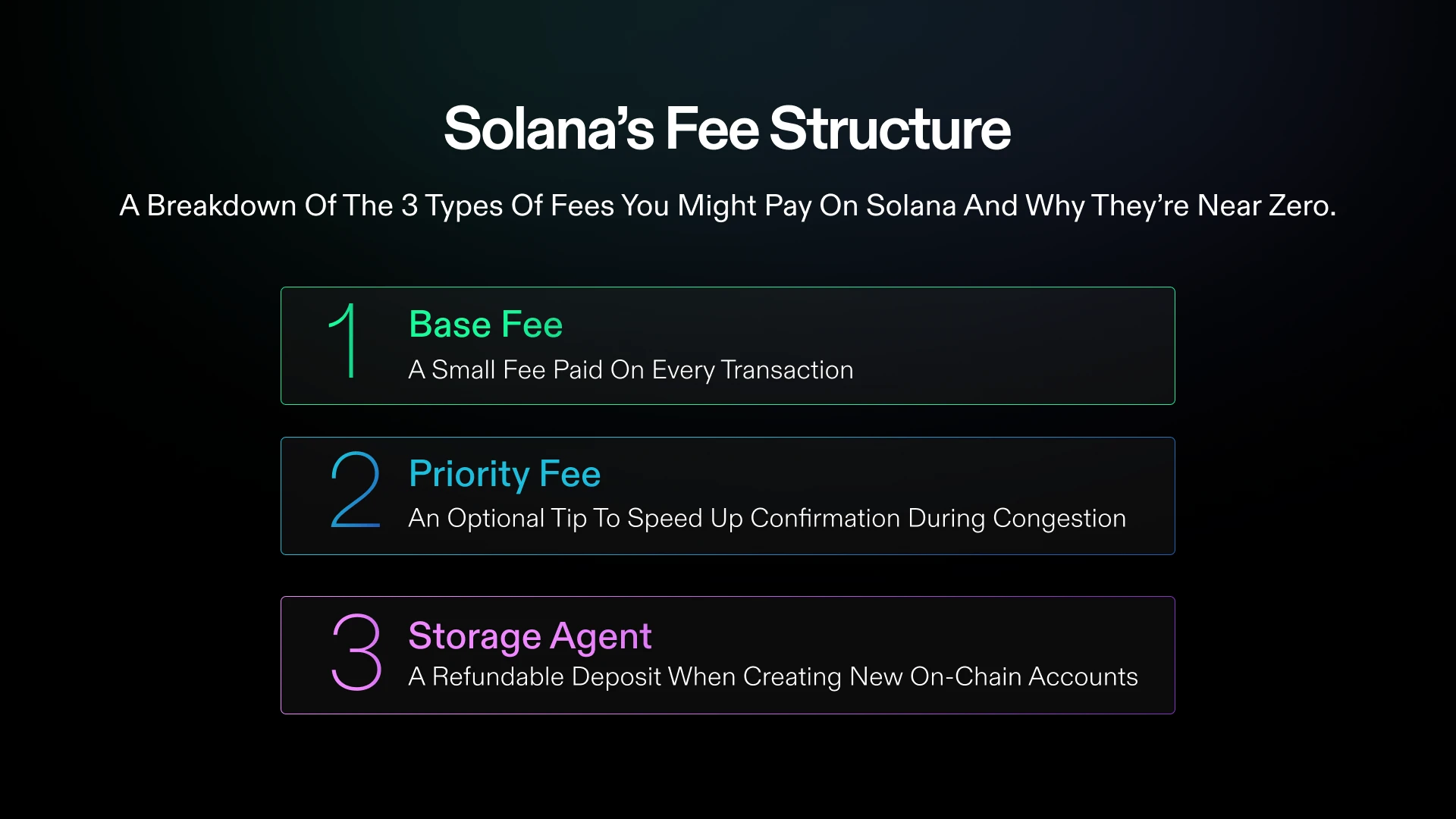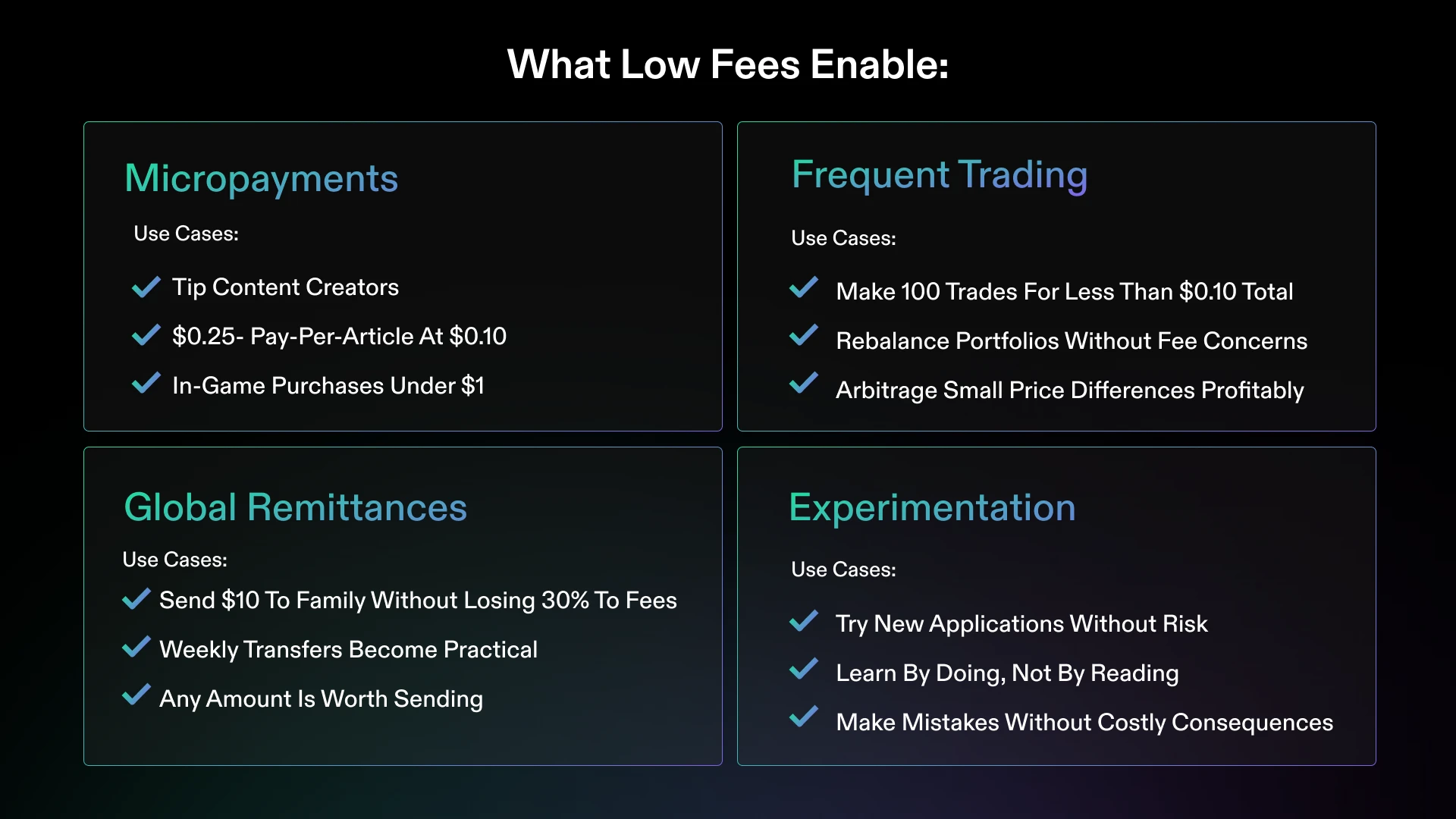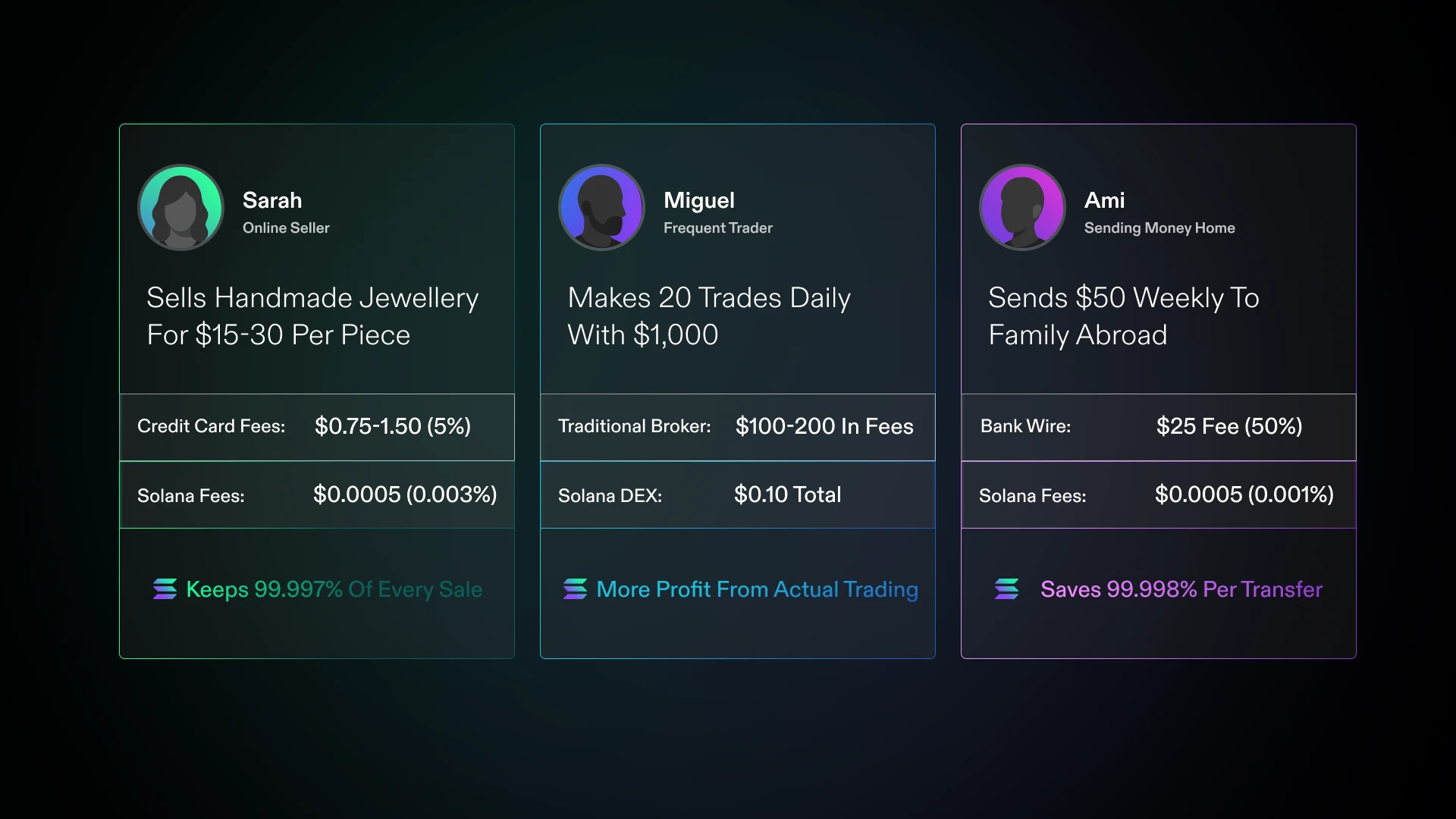Understanding Solana Transaction Fees
Learn how transaction fees work on Solana, why they're low, and what this means for different use cases.
Understanding Solana Transaction Fees
Transaction fees are an important part of any digital network. On Solana, fees are designed to be predictable and affordable, typically costing fractions of a cent. This chapter explains how fees work and why they matter for accessibility.
What You'll Learn
In this chapter, we'll cover:
- Why networks need transaction fees
- How Solana's fee structure works
- Typical costs for different activities
- When and why fees might vary
- How low fees enable new use cases
Why Transaction Fees Exist
Transaction fees serve important purposes:
- Compensate validators: The computers that process transactions and secure the network
- Prevent spam: Even tiny fees discourage network abuse
- Prioritize transactions: Optional priority fees for time-sensitive needs
On Solana, fees are kept minimal while still serving these functions.
Solana's Fee Structure
 Breakdown of Solana's three fee types: Base Fee, Priority Fee, and Storage Rent
Breakdown of Solana's three fee types: Base Fee, Priority Fee, and Storage Rent
Base Fee
Every transaction pays a base fee of 0.000005 SOL (5,000 lamports). At $100 per SOL, that's $0.0005 - half a tenth of a cent.
Priority Fees
During busy periods, you can add a small priority fee to process faster. These typically remain under $0.01 even during high demand.
Storage Rent
Creating new accounts (like token accounts) requires a small deposit (~0.002 SOL) that's refundable when the account is closed.
Typical Transaction Costs
Here are real examples of what you'll pay:
| Action | Typical Cost | In USD (at $100/SOL) |
|---|---|---|
| Send SOL | 0.000005 SOL | $0.0005 |
| Send tokens | 0.000005 SOL | $0.0005 |
| Swap tokens | 0.000005 SOL | $0.0005 |
| Buy an NFT | 0.000005-0.001 SOL | $0.0005-0.10 |
| Create token account | ~0.002 SOL | $0.20 (refundable) |
For comparison, traditional systems charge:
- Wire transfer: $15-50
- International transfer: $25-75
- Stock trade: $5-10
How Solana Keeps Fees Low
Solana achieves low fees through technical design:
Parallel Processing
Like a multi-lane highway, Solana processes many transactions simultaneously rather than one-by-one.
Efficient Consensus
Proof of History enables validators to agree quickly without extensive communication.
Predictable Costs
Unlike auction-based fees, Solana's fees remain stable regardless of network activity.
What Low Fees Enable
 Grid showing four categories of use cases enabled by low fees: Micropayments, Frequent Trading, Global Remittances, Experimentation
Grid showing four categories of use cases enabled by low fees: Micropayments, Frequent Trading, Global Remittances, Experimentation
Micropayments
- Tip content creators $0.25
- Pay-per-article at $0.10
- In-game purchases under $1
Frequent Trading
- Make 100 trades for less than $0.10 total
- Rebalance portfolios without fee concerns
- Arbitrage small price differences profitably
Global Remittances
- Send $10 to family without losing 30% to fees
- Weekly transfers become practical
- Any amount is worth sending
Experimentation
- Try new applications without risk
- Learn by doing, not by reading
- Make mistakes without costly consequences
Understanding Fee Markets
During exceptional demand (like popular NFT launches), you might see:
Normal Times
- Base fee only: 0.000005 SOL
- Instant confirmation
- No competition for block space
Busy Periods
- Add priority fee: 0.0001-0.001 SOL
- Still under $0.10 total
- Faster processing for urgent needs
How to Set Fees
Most wallets handle this automatically, but you can:
- Use default settings for normal transactions
- Increase priority for time-sensitive actions
- Check network status if unsure
Practical Examples
 Three real-world scenarios comparing traditional vs Solana fees: Sarah (online seller), Miguel (trader), Ami (remittances)
Three real-world scenarios comparing traditional vs Solana fees: Sarah (online seller), Miguel (trader), Ami (remittances)
Sarah - Online Seller
Sells handmade jewelry for $15-30 per piece
- Credit card fees would take $0.75-1.50 (5%)
- Solana fees: $0.0005 (0.003%)
- Keeps 99.997% of every sale
Miguel - Frequent Trader
Makes 20 trades daily with $1,000
- Traditional broker: $100-200 in fees
- Solana DEX: $0.10 total
- More profit from actual trading
Ami - Sending Money Home
Sends $50 weekly to family abroad
- Bank wire: $25 fee (50%)
- Money transfer service: $5 fee (10%)
- Solana: $0.0005 fee (0.001%)
Managing Transaction Fees
Best Practices
- Keep 0.1 SOL in your wallet for fees
- Use normal priority for most transactions
- Only increase priority when time-sensitive
- Close unused token accounts to reclaim rent
Fee Estimation
Wallets show estimated fees before confirming. Always review:
- Base transaction fee
- Any priority fee added
- Total cost in SOL and USD
Common Questions
Why do I need SOL for fees?
All Solana transactions require SOL for fees, even when sending other tokens. Think of it like needing stamps to mail letters.
Can fees suddenly spike?
While priority fees can increase during high demand, they typically stay under $0.01. Base fees remain constant.
What if I can't afford the fee?
You'll need a small amount of SOL to pay for transaction fees. Most users purchase SOL from exchanges or receive it from friends to get started.
Do failed transactions charge fees?
Yes, because validators still process them. However, at $0.0005, this isn't financially significant.
What's Next
Now that you understand fees, you're ready to make your first transaction. In the next chapter, you'll practice sending and receiving SOL, experiencing these low fees firsthand.
Remember: Solana's low fees aren't just about saving money - they're about making digital transactions accessible to everyone, enabling use cases that simply don't work with high fees.